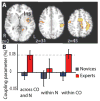BOLD signal in insula is differentially related to cardiac function during compassion meditation in experts vs. novices
- PMID: 19426817
- PMCID: PMC2854658
- DOI: 10.1016/j.neuroimage.2009.04.081
BOLD signal in insula is differentially related to cardiac function during compassion meditation in experts vs. novices
Abstract
The brain and the cardiovascular system influence each other during the processing of emotion. The study of the interactions of these systems during emotion regulation has been limited in human functional neuroimaging, despite its potential importance for physical health. We have previously reported that mental expertise in cultivation of compassion alters the activation of circuits linked with empathy and theory of mind in response to emotional stimuli. Guided by the finding that heart rate increases more during blocks of compassion meditation than neutral states, especially for experts, we examined the interaction between state (compassion vs. neutral) and group (novice, expert) on the relation between heart rate and BOLD signal during presentation of emotional sounds presented during each state. Our findings revealed that BOLD signal in the right middle insula showed a significant association with heart rate (HR) across state and group. This association was stronger in the left middle/posterior insula when experts were compared to novices. The positive coupling of HR and BOLD was higher within the compassion state than within the neutral state in the dorsal anterior cingulate cortex for both groups, underlining the role of this region in the modulation of bodily arousal states. This state effect was stronger for experts than novices in somatosensory cortices and the right inferior parietal lobule (group by state interaction). These data confirm that compassion enhances the emotional and somatosensory brain representations of others' emotions, and that this effect is modulated by expertise. Future studies are needed to further investigate the impact of compassion training on these circuits.
Figures




References
-
- Allen JJ, Chambers AS, Towers DN. The many metrics of cardiac chronotropy: A pragmatic primer and a brief comparison of metrics. Biological Psychology. 2007;74(2):243–262. - PubMed
-
- Benson H. The relaxation response: Therapeutic effect. Science (New York, NY) 1997;278(5344):1694–1695. - PubMed
-
- Bradley MM, Lang PJ. Affective reactions to acoustic stimuli. Psychophysiology. 2000;37(2):204–215. - PubMed
-
- Carlson LE, Speca M, Faris P, Patel KD. One year pre-post intervention follow-up of psychological, immune, endocrine and blood pressure outcomes of mindfulness-based stress reduction (MBSR) in breast and prostate cancer outpatients. Brain, Behavior, and Immunity. 2007;21(8):1038–1049. - PubMed
Publication types
MeSH terms
Grants and funding
LinkOut - more resources
Full Text Sources
Medical

